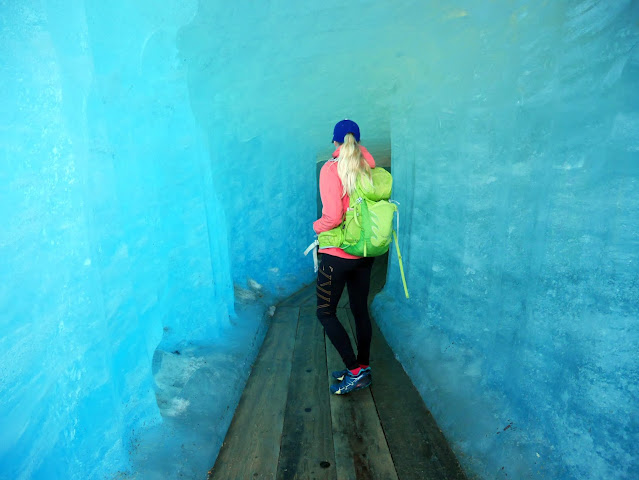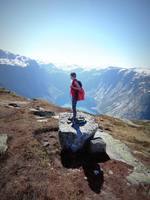Through Swiss passes: Grimsel, Furka, Gotthard
After visiting the gorge on the Aare River, see the previous article entitled Our 2 days in the Interlaken area, we did not return to Interlaken. Our home for the night was the Terrasse Nessental guesthouse a few kilometres away, which, thanks to the excellent owner and the excellent rösti, I can recommend with a clear conscience. We paid about €100 for a room with private bathroom, breakfast and free parking. Oh, and for those who don't know what rösti is - it's probably most similar to hashbrown (potato pancakes). The base is a pancake of grated potatoes and then on top comes whatever you're in the mood for. It can be cheese, bacon, vegetables, mushrooms or maybe ox eye etc., and together it's one big YUM!
From Terrasse Nessental in the morning we start to climb three high mountain passes - Grimselpass, Furkapass and Gotthardpass. I am looking forward to enjoying the views of the green valleys, the surrounding mountain giants and the winding serpentine roads, but the reality is far from my expectations. At least this is true for the Grimselpass, which connects the canton of Bern (Bernese Alps) and the canton of Valais (Urner Alps). The road passes by several dams and its highest point is at 2164 m above sea level. Too bad. In practice it looked like this...

|

|
Luckily the weather will calm down at least for the Furkapass passage, ufff. This pass has its highest point at 2,429 metres above sea level and connects Gletch in the canton of Valais with Realp in the canton of Uri. And of course the Grand Tour of Switzerland passes through it. Have you heard of it? It's a kind of tour through the whole of Switzerland, taking you through the biggest must-sees. It's often marked on the roads, at the classic signposts, oh and then there's always a red photo gate at the interesting places, see photo below. The whole Grand Tour is 1,600 km long, but you can ride part of it. Check out the official website, it's very interactive, too much for my taste, but maybe it will interest you or help you make your own itinerary for visiting Switzerland. And now I'll give you some tips on places I think are worth a stop when passing through Furkapass.

|

|
Rhonegletcher
Probably the most prominent place in the whole Furkapass. It makes the Rhone Glacier very accessible and has become a bit of a commercial affair. Beneath the glacier's tongue is a pool of runoff water, which, as the name suggests, is the source of the Rhone River itself, which then feeds Lake Geneva before crossing into France and flowing into the Mediterranean.
Accessibility: the car park is free of charge and features a fast food stand and a souvenir shop. However, if you want to see the glacier for yourself, you'll have to pay admission, otherwise you'll see a fart from the parking lot. Admission in 2021 comes to CHF 9 for an adult and beware cash only (card payment was an extra charge). For this price you can enjoy the view of the glacier from the viewing platform, read the educational boards and check out the Eis Grotte = Ice Cave.
On the info boards you may be surprised to see pictures/photos from the end of the 19th century showing the Rhonegletcher ending at the village of Gletcher, where the Furkapass rises from the valley. But it has shortened by more than 1.5 kilometres since then! X thousand years ago, of course, it covered an even larger area, and was even the largest glacier in Switzerland, reaching as far as Geneva. Nowadays it also has one first place, but not a very happy one... it is one of the fastest melting glaciers in the world. Excellent comparative images (with sliders) are available on this site, so anyone interested, be sure to check it out. I would therefore recommend to hurry up with your visit, as it is also possible that in a "while" there will be nothing left to look at.

|

|

|

|
Eis Grotte
Honestly, this was a big disappointment for me. I can't say exactly what I imagined, but I've read nothing but praise and amazement from various sources. An ice tunnel with an ice chamber has been carved here since 1870, measuring about 100 metres at the start of the season, and getting shorter as the season gets warmer (and the crowds of tourists flow in).
Our experience - we visited the glacier in July, at the beginning of the season, and there were only a handful of people there. It is impressive in itself, but there was still something strange about it. Then it dawned on us. The bottom part is covered with white blankets... normally like throwing a blanket over a glacier (?!). But not just any blanket, it's a special blanket that resists UV rays and protects the ice from melting. The efficiency is said to be 50%, and even that is not enough to save the day, because they can't cover the whole glacier. Most of the "blankets" are of course above the Ice Cave, so let's go check it out.

|

|

On a few meters you can see the bright blue ice, which creates the desired wow effect, and which you can see in the photos you have googled. The rest of the Ice Cave is made up of dripping ice supported by a structure and covered with white sheets of canvas. The ice chamber wasn't even there. All in all, our visit to the ice tunnel took us about 5 minutes, we wanted to be out as quickly as possible because I can't quite say we felt very safe inside. For comparison, I'll throw in a picture from 2007, not too long ago, when the entrance to the cave looked completely different. Well... it's just sad cinema, and in a few years time they probably won't even have anywhere to excavate Eis Grotte.

Hotel Belvédère
The place from the opening photo of this article, the formerly famous Hotel Belvédère. It was built in the late 19th century and within a few decades became one of the most popular hotels in the Swiss Alps. It is located right in one of the serpentine hills, about 200 metres from the entrance to the Rhonegletcher glacier. In the days of its greatest glory, guests had the most luxurious view, as the glacial abseil could be seen directly from the hotel windows. However, over the years, the ice mass has diminished very noticeably due to climate change and has encroached less and less on the valley, and the interest in local accommodation has gradually diminished. People passing through only needed a couple of hours to visit the glacier, then stopping at the hotel for coffee or lunch, but the motivation to stay overnight was no longer there. The end of service was announced in 2016 and now this iconic hotel serves only as a fine photo attraction.
Furkapass also became a film location for one Bond movie, namely Goldfinger from 1964. Here, Sean Connery and his Aston Martin cut corners in a chase with Goldfinger's Rolls Royce, even passing the Belvedere Hotel. These cinematic views were already spectacular, let alone in person.
On the eastern side of the pass, just above the village of Realp, there is even a place called James Bonds Strasse. On google maps, enter it as "James Bond Parklücke". You'll find a parking space for two cars or so, a bench, and a sign commemorating Sean Connery that even plays the theme song from Goldfinger. Right from here you get a great view of the valley, the grazing cows and the Realp.
My last tip is located about 10 km behind Realp, so it is not part of Furkapass anymore, but of the third today's pass - Gotthardpass, which connects the Italian canton of Ticino with the canton of Uri.
The name Teufelbrücke translates as Devil's Bridge, which is of course associated with a legend. The most beloved one is about how the locals tried to build a bridge across the river, which they couldn't manage. In the end, they summoned the devil himself to help them. He built the bridge for them, but on the condition that he would take the first soul to cross over to the other side. But the locals outwitted the devil and sent a goat across the bridge first.
Rumours aside, the Devil's Bridge spans the Reuss River, which flows through the Schöllenen Canyon, and is even the narrowest point of the entire Gotthard Pass. The original bridge was built in the 13th century out of wood, and today... that's another story. Today there are three bridges to see! One for cars, one for pedestrians and one for trains... all made of stone.


|

|
Accessibility - right by the road there is a parking lot where you can park for 45 minutes for free. You can make a short detour (you can find it as Rundweg Schöllenen on maps.cz), during which:
- you will see a few meters of Russian territory - specifically the monument to General Suvorov, which the Swiss donated to the Russians for their help in the battle against Napoleon.
- from the monument you can also take the via ferrata Diavolo (B/C)
- you will enjoy the view of all 3 bridges and the breathtaking Schöllenen Canyon
- on the railway bridge you may be lucky enough to see the famous red Glacier Express train
- pass through the military tunnel in the rocking
 |
 |
If you don't opt for the ferrata, you can do everything described above + a bunch of photos during the 45 minutes of free parking. Pretty convenient stop, huh? No seriously, it's really worth it, so if you're passing through here, definitely put Devil's Bridge on your agenda. Well... I'd say we've done a lot in one day, so I've saved the last location from our week-long wander through Switzerland for another post - see Saxer Lücke + a bit of Liechtenstein.
If this information has helped you to save some time or money or both, you can "invite me for a coffee" and contribute to the running of Travel with Donuts :) account number / QR kód: 1257951017/3030










































Žádné komentáře: